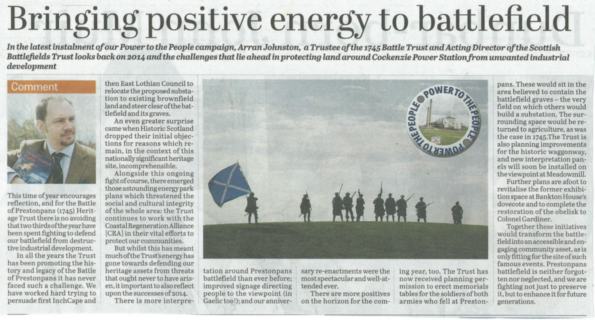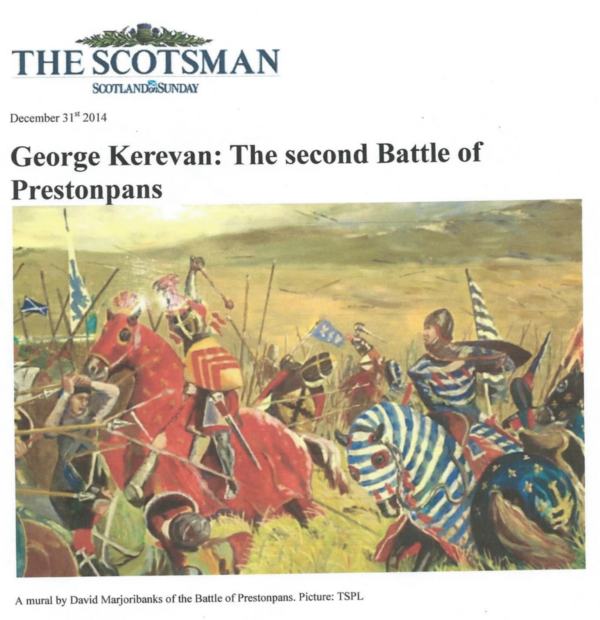Battle Trust determined to win in 2015 ... not fight last year's battles!
As Arran Johnston comments, too much time in 2014 was spent fighting battles that should never have been initiated!


Ed: No wish to be churlish about this excellent piece in The Scotsman, George, but the picture's not quite right. In fact it's absolutely wrong. But read on, as we said George's piece is on the button .... and there's Kate Mavor's comments from the National Trust for Scotland to digest at the end too ...
"SCOTLAND’S public bodies must reassess their priorities and put preservation before profit, writes George Kerevan.
In the early morning of 21 September, 1745, the insurgent forces of Charles Edward Stuart, son of the Jacobite claimant to the thrones of Scotland and England, defeated a British army led by Sir John Cope. The fateful meeting of the two armies took place just outside Edinburgh, at Prestonpans in East Lothian. Thereafter, the Battle of Prestonpans would be immortalised in the infamous ditty Heigh! Johnnie Cowp, are ye wauken yet?
"As we enter 2015, a second Battle of Prestonpans is in the offing – one with significant negative consequences for the natural environment and economy of East Lothian and Scotland. Like its historic predecessor, this conflict pits an insurgent community against bureaucratic, self-interested foes, including Scottish Power, the Conservative-Labour administration on East Lothian Council and Historic Scotland, the very public body tasked with preserving Scotland’s historic heritage.
"At the beginning of September, East Lothian Council granted permission for a controversial electricity substation to be built on a substantial portion of the site of the original Battle of Prestonpans, which still contains the human remains of hundreds of soldiers who fell during the fighting. 'Substation' is a polite term for a major bit of kit that will bring electricity onshore from a giant wind farm. This is being constructed by a company called Inch Cape Offshore Windfarms Ltd. Inch Cape Offshore sounds rather innocuous. Nothing could be further from the truth. It is a joint venture between Repsol, Spain’s biggest oil company, and Energias de Portugal, one of Europe’s biggest electricity firms. By the way, EDP is one-third Chinese state-owned while Inch Cape has a strategy of using Chinese engineering technology for its UK windfarms.
"According to a report in The Guardian, parent Repsol has just secured permission from the Peruvian government to explore for oil in an area earmarked as a reserve for indigenous people, in the Amazon rain forest.
According to Repsol’s own environmental impact assessment, this project will require building 42 camps, 75 heliports, 3,800 “drop-zones” and 2,343 miles of pathway cut in the forest.
"Of course, Inch Cape has to get its electricity on shore somewhere. In fact, there was a major study done to determine the best spot.
"So how come they fixed on a historic battlefield? And why did Historic Scotland withdraw its objections at the final stage, after the company made only cosmetic changes to the scheme? Answer: our public regulatory and heritage bodies have been subverted in the last few decades into commercial agencies, run by staff imported from the private sector.
"I accuse no-one of corruption. But I believe that bodies such as the National Trust for Scotland and Historic Scotland now see their primary role as economic regeneration rather than environmental protection. Or at least, they will retreat if told by Scottish Enterprise, or some local authority, that resistance will jeopardise employment.
"In the Cockenzie case, Scottish Enterprise is the main culprit. The existing Cockenzie power station is being de-commissioned, providing a golden opportunity to use the site to strengthen East Lothian’s attraction to visitors (which creates jobs, of course).
"But Scottish Enterprise wants to turn Cockenzie into a 'hub' for the offshore wind industry, which includes the associated Inch Cape substation. The scale of the project is truly gargantuan. It would swallow up the site of the power station, a coal handling plant area to south, and land at Blindwells currently earmarked for housing. According to Scottish Enterprise, the energy park (a euphemism, surely) would host the manufacture and repair of giant turbines. A deep water quay necessary for transporting the turbines might double as a dock for cruise ships.
"True, the Scottish Government’s National Planning Framework identifies Cockenzie as a possible location for an energy hub. But we should treat such paper exercises with a pinch of salt, especially after the fall in oil prices. I suspect there are other motives involved to do with land values.
"The hub project is being supported by Scottish Power (another Spanish energy utility) which owns the land and is desperate to recover some of its dosh now that EU environmental rules have closed the plant. Scottish Power seems happy to let Scottish Enterprise use public cash to talk up the energy hub. If nothing else, that will increase the value of the land.
"In reality, the Scottish Enterprise proposal for Cockenzie is a commercial fantasy. Even if the turbines are not manufactured and repaired in China (a big “if”), Cockenzie is too late to get in the queue.
"In August, the Scottish Government gave the green light for a 400-acre site at Ardersier, near Inverness, to become a base for offshore wind turbine construction. Other sites are being touted. Kishorn, Cromarty and Nigg have all signed agreements with Highlands and Islands Enterprise to develop land for similar production and repair facilities.
Faced with such competition, the cost of developing the Cockenzie site looks excessive. According to Scottish Enterprise, the new quay would cover nearly 24 acres. Access to the new industrial plant would necessitate realigning the B1348 Edinburgh Road and re-routing the recently completed John Muir Way. Can you really see Scottish Enterprise paying for all that, because Scottish Power won’t.
"Is there an alternative to this silly scheme? Fortunately, the hard-headed folk of East Lothian, organised in the Coastal Regeneration Alliance, have come up with something a lot better. At its heart is a proposal to transform the old power station into a national arts venue, shopping centre and a performance arena called Athena.
"No British army battle honours were ever awarded for Prestonpans, though they exist for other strategic disasters, such as Crete and Singapore. It would be a fitting tribute to those who died on both sides in 1745 if we saved the historic site of the Battle of Prestonpans as their memorial rather than an industrial wasteland."
_____________________________________________________________________
Published in The Scotsman 06/01/2015
from Kate Mavor, Chief Executive, The National Trust for Scotland, Edinburgh
"George Kerevan made a number of good points about the protection of a historic battlefield (“The second battle of Prestonpans”, Perspective, 31 December 2014) but his assertion that the National Trust for Scotland’s “primary role” is seen as “economic regeneration” or that we “will retreat if told by Scottish Enterprise” is not among them.
The Trust is a charity and independent of government. Our primary purpose is conservation and the majority of our funding comes from our 320,000 members, as well as generous donors and supporters, and not the public sector. I am not aware of any situation where we have compromised conservation of the 129 properties we care for at the behest of any ¬government ¬agency for political or economic ends. That is not to say that -heritage does not make a valuable contribution to ¬Scotland’s economy.
In this newspaper last April, Terry Levinthal, our director of conservation and projects, ¬relayed the results of a 2007 study showing that the historic environment alone contributed in excess of £2.3 billion (2.6 per cent) to Scotland’s national gross value added, and accounted for 2.5 per cent of total employment, well ahead of fisheries and agriculture.
However, Mr Kerevan is right to draw attention to the effects of short-term thinking and inappropriate development on sites of historic or natural importance.
This is something we are acutely aware of and contend that the planning system requires better balance in assessing heritage value and the needs of local communities: it is not right that charities or local activists with scant resources should be left to face down well-funded commercial interests.
While Prestonpans is not one of the sites we care for, we can perhaps take comfort from the promise made by the former planning minister to the Scottish Parliament on 21 May in which he said the Scottish Government would take steps “to ensure planning authorities protect, conserve and where -appropriate seek to enhance, the key landscape characteristics and special qualities of sites on the current inventory of historic battlefields”.
Should this promise not be kept, it suggests that we and others need to do more to encourage further review of planning policy.
Published Date: January 7th 2015
|





